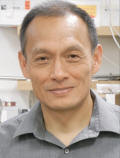Awardee Interviews | Biography: Wilson Ho
Wilson Ho

Dr. Wilson Ho, University of California, Irvine, “for the development and application of atomic scale inelastic electron tunneling with the scanning tunneling microscope.”
Wilson Ho spent his early childhood in Changhwa, a city near the middle of Taiwan, where he received his primary school education. His parents believed that there were more opportunities abroad for their four children. In 1965, when he reached the age of 12, his family moved to Rokko, a suburb of Kobe, Japan, and two years later they immigrated to San Francisco, California. In 1971, he attended the California Institute of Technology and received B.S. and M.S. degrees in Chemistry in 1975. He had fond memories of carrying out research each summer with different professors: Aron Kuppermann, Wilse Robinson, William Goddard, and Henry Weinberg. Surface science was a rapidly emerging field at that time and he went to the University of Pennsylvania to carry out Ph.D. studies under the guidance of Professors Ward Plummer and Robert Schrieffer. During this period, he learned to appreciate the design and fabrication of novel instruments and became fully ingrained with the belief that development of new techniques could lead to discoveries in science. In 1979, he received his Ph.D. degree in Physics and joined AT&T Bell Laboratories as a Member of Technical Staff. In 1980, he started his academic career as a faculty member in Physics at Cornell University, prior to joining the University of California, Irvine in 2000 as Donald Bren Professor of Physics and Chemistry.
His research has been focused on understanding quantum phenomena by studying molecules on solid surfaces. He discovered impact scattering and a new selection rule for high resolution electron energy loss (vibrational) spectroscopy (EELS). Recognizing the importance of time resolved measurements, he constructed multichannel electron detectors in EELS and femto-second lasers for time resolved studies on surfaces. Over the last 15 years, he has been fascinated by precision measurements on single atoms, molecules, and artificial nanostructures, in particular their interiors that can be uniquely probed by homemade, low temperature (10 K to 700 mK), ultrahigh vacuum scanning tunneling microscopes (STM). The desire to push the limits of measurement led to the detection of vibrations of a single bond; single molecule rotation, diffusion, intramolecular vibrational relaxation, bond breaking and formation; the synthesis of new molecules and quantum structures by atomic and molecular manipulation; single-molecule optical phenomena with 0.1 nm resolution, including fluorescence spectroscopy, optical imaging, and cw and femtosecond laser-induced electron transfer; as well as single-spin excitation spectroscopy and imaging, spin-vibronic coupling, and the detection of spin-related properties in molecules without unpaired electrons. His research continues to focus on the exploration of the interior of single molecules and nanostructures and its coupling to external perturbations by photons, electrons, and magnetic fields (up to 9 Tesla). He is currently extending the STM into the frequency (up to 2 GHz) and time (<30 fs) domains as well as high energy resolution spectroscopy and imaging (~100 µV or sub-cm-1). He is particularly proud that some of his research results have found their way into textbooks and the successes his former students have achieved in their careers.